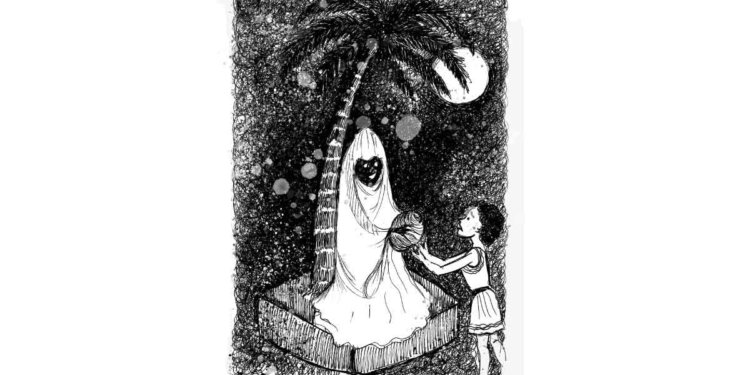Story: The Coconut Run
I was nine years old when I witnessed a suicide in my building. It happened during the summer vacation of 1979.
Mrs Sukerkar from the flat on fourth floor was being treated for a mental illness; she had been depressed and suicidal for many years. One bright morning whilst my friends and I were playing hide and seek and had dispersed to hide in the stilt parking area, there was a loud thud. Mrs Sukerkar had jumped from her balcony. We kids were the first to run to her. There was so much blood on the hard concrete ground; her skeletal body a mess of mangled bones, her face smashed, her jaw dislocated…and she was still alive. She was taken to The Cooper Hospital where she breathed her last after more than an hour.
Our building had a well-tended garden in those days— a luxury for Bombay buildings, it was on the perimeter while the centre of the compound was hard concrete. Most of the residents were Goans– Hindus and Catholics, and they had created a semblance of pastoral Goa in the building, at least with the tree cover. A lush lawn had mango trees, ashoka trees, drumstick trees, papaya, sitaphal and ramphal trees, and one very fertile coconut tree. At the back of the building stood this lone coconut tree with a cemented sitting area around its base. All the building aunties would sit there in the evenings and trade gossip. Even Sukerkar aunty, before she fell ill. The spot where she jumped and left a huge bloody mark was barely 5 metres from this sitting area. A week after her suicide, normalcy returned to the building as the cops stopped their visits, bereaved relatives returned to their own homes and we kids got back to playing in that area again. But something had changed…
Every year during summer vacations, we kids played late into the night. There was a badminton court in the compound and our dads would return from work and join us for a round of night badminton. But after the suicide, many parents forbade their kids from playing in that area after dark. The building aunties stopped sitting under the coconut tree where Mrs Sukerkar also liked to sit- perhaps out of respect for her memory, or perhaps in fear. A week after the incident our watchman quit, he was too scared to patrol at night. Rumours began floating around, started by the neighbouring buildings mostly. People claimed to have seen a ghostly apparition sitting under the coconut tree. I remember my mother scolding our maid one morning, telling her that ghosts do not exist, at least not in big cities like Bombay… In any case, we would be the first to see her ghost, since our kitchen window and balcony overlooked the badminton court and the coconut tree.
One night I decided to stay awake and to see the ghost of Mrs Sukerkar. I sat on a tall stool in the kitchen balcony, rearranging the potted plants on the sill to camouflage myself. I sat till dawn but she did not come. I sat for 3 more nights with no luck. I was very disappointed. My mom made me understand that I wasn’t born under the right ‘nakshatra’. Apparently people born under Jyeshta Nakshatra can see ghosts as they are more receptive to paranormal energies. But news from the grapevine said that the ghost showed up under the coconut tree on all 4 days that I kept watch. Really? My goddamn nakshatras?
There was another routine in our building. With so many Goan families and just one coconut tree meant that every time a coconut fell, there would be a scramble to appropriate it. Anything for a coconut men! Every quarter, a professional coconut plucker was called and every family(there were twenty eight) received at least five coconuts— which, most Goans will tell you, is just five days curry’s worth. So these unseasonal, falling coconuts were prized. There were two things that came in handy for the ‘Coconut Run’- good hearing and good running skills— not necessarily in one individual. My mom and I made a fine team. She could recognize the sound made by a falling coconut even in her sleep. Some nights at 2 am I would hear her shout “Bina, run!” – that was my cue to bolt from my bed, open the main door and run as fast as I could. Down the single flight of stairs, then a fifty metres dash to the coconut tree base. This was done on autopilot- no questions asked, no slippers worn. There were times when more than one person (usually kids- sometimes an embarrassed uncle) landed up at the same time – but you still had to search for the coconut in all the foliage and shrubbery below. We were all good runners – all of us scrawny fish eating Goan kids, our legs strengthened by daily doses of football and hockey – remember this was before channel TV and Internet- fitness was unavoidable for us. But I cannot boast about getting the most coconuts, no, there were at least 3 boys and 2 girls who ran faster than me. But after the suicide, parents stopped sending their kids on a coconut run after dark. Earlier we ran happily at 2— even 3 am, now nobody was running at 7pm. Which was sad. My mom was happy though- she wasn’t afraid of ghosts. So I ran uncontested for many months after the suicide. My mom was a pragmatic Goan lady. She believed in the existence of ghosts, in principle, but she was of the opinion that one must not fear them. She would tell me, “If her ghost accosts you, just toss the coconut, after all she’s a Goan ghost, she will get distracted and run to catch the coconut, forgetting all about you.” Sound Goan logic that. Soon my coconut run turned into a coconut walk. With nobody breathing down my neck— not even a ghost, “Bina, run!” brought on a yawn. My mom understood my predicament and at times went and retrieved the coconuts herself. I think a full year passed this way and even Mr Sukerkar moved on. We all welcomed the second Mrs Sukerkar- also a Goan lady from Agasaim. Slowly the rumours faded and the coconut run was back!







